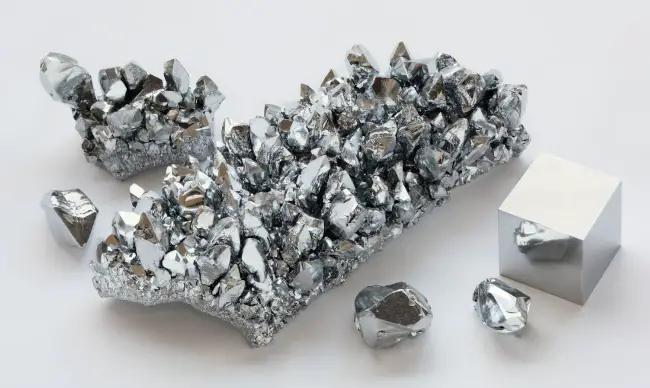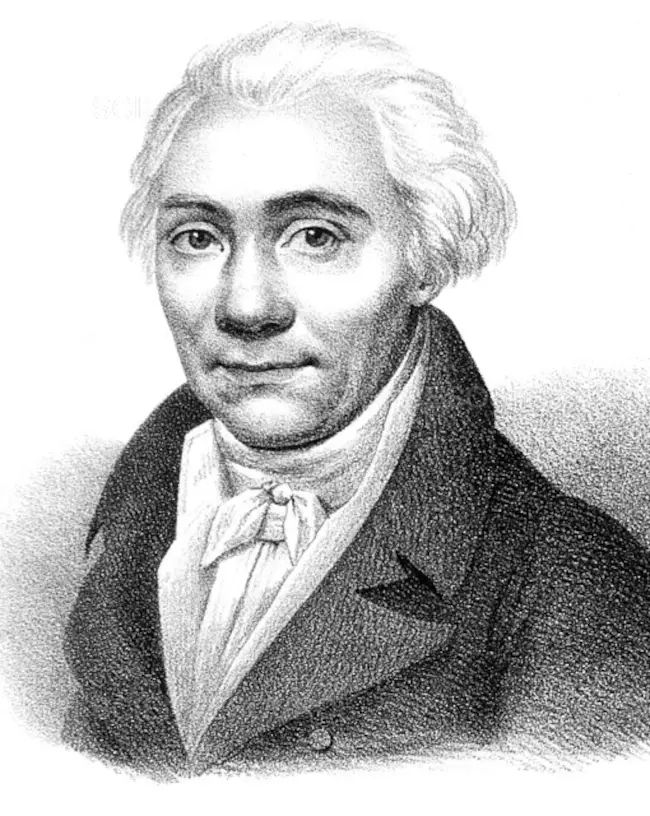
Chromium (Cr) is a chemical element of the periodic table, located in the group 6 and the period 4, and has the atomic number 24. It is a hard, lustrous, silvery-grey transition metal, whose name comes from the Greek word “Chroma”, which means color. It is the 21th most abundant element on earth.
On periodic table
| group | ⇨ | 1 | 2 | 3 | 4 | 5 | 6 | 7 | 8 | 9 | 10 | 11 | 12 | 13 | 14 | 15 | 16 | 17 | 18 |
| period | ⇩ | ||||||||||||||||||
| 1 | 1 H  Hydrogen |
2 He  Helium |
|||||||||||||||||
| 2 | 3 Li  Lithium |
4 Be  Beryllium |
5 B  Boron |
6 C  Carbon |
7 N  Nitrogen |
8 O  Oxygen |
9 F  Fluorine |
10 Ne  Neon |
|||||||||||
| 3 | 11 Na  Sodium |
12 Mg  Magnesium |
13 Al  Aluminium |
14 Si Silicon |
15 P  Phosphorus |
16 S  Sulfur |
17 Cl  Chlorine |
18 Ar  Argon |
|||||||||||
| 4 | 19 K  Potassium |
20 Ca  Calcium |
21 Sc  Scandium |
22 Ti  Titanium |
23 V  Vanadium |
24 Cr Chromium |
25 Mn  Manganese |
26 Fe  Iron |
27 Co  Cobalt |
28 Ni  Nickel |
29 Cu  Copper |
30 Zn  Zinc |
31 Ga  Gallium |
32 Ge  Germanium |
33 As  Arsenic |
34 Se  Selenium |
35 Br  Bromine |
36 Kr  Krypton |
|
| 5 | 37 Rb  Rubidium |
38 Sr  Strontium |
39 Y  Yttrium |
40 Zr  Zirconium |
41 Nb  Niobium |
42 Mo  Molybdenum |
43 Tc  Technetium |
44 Ru  Ruthenium |
45 Rh  Rhodium |
46 Pd  Palladium |
47 Ag  Silver |
48 Cd  Cadmium |
49 In  Indium |
50 Sn  Tin |
51 Sb  Antimony |
52 Te  Tellurium |
53 I  Iodine |
54 Xe  Xenon |
|
| 6 | 55 Cs  Caesium |
56 Ba  Barium |
72 Hf  Hafnium |
73 Ta  Tantalum |
74 W  Tungsten |
75 Re  Rhenium |
76 Os  Osmium |
77 Ir  Iridium |
78 Pt  Platinum |
79 Au  Gold |
80 Hg  Mercury |
81 Tl  Thallium |
82 Pb  Lead |
83 Bi  Bismuth |
84 Po  Polonium |
85 At  Astatine |
86 Rn  Radon |
||
| 7 | 87 Fr  Francium |
88 Ra  Radium |
104 Rf  Rutherfordium |
105 Db  Dubnium |
106 Sg  Seaborgium |
107 Bh  Bohrium |
108 Hs  Hassium |
109 Mt  Meitnerium |
110 Ds  Darmstadtium |
111 Rg  Roentgenium |
112 Cn  Copernicium |
113 Nh  Nihonium |
114 Fl  Flerovium |
115 Mc  Moscovium |
116 Lv  Livermorium |
117 Ts  Tennessine |
118 Og  Oganesson |
||
| 57 La  Lanthanum |
58 Ce  Cerium |
59 Pr  Praseodymium |
60 Nd  Neodymium |
61 Pm  Promethium |
62 Sm  Samarium |
63 Eu  Europium |
64 Gd  Gadolinium |
65 Tb  Terbium |
66 Dy  Dysprosium |
67 Ho  Holmium |
68 Er  Erbium |
69 Tm  Thulium |
70 Yb  Ytterbium |
71 Lu  Lutetium |
|||||
| 89 Ac  Actinium |
90 Th  Thorium |
91 Pa  Protactinium |
92 U  Uranium |
93 Np  Neptunium |
94 Pu  Plutonium |
95 Am  Americium |
96 Cm  Curium |
97 Bk  Berkelium |
98 Cf  Californium |
99 Es  Einsteinium |
100 Fm  Fermium |
101 Md  Mendelevium |
102 No  Nobelium |
103 Lr  Lawrencium |
|||||
| – d block |
Chromium is a d-block element, situated in the sixth column of the periodic table, between vanadium (V) and manganese (Mn). It has the atomic number 24 and is denoted by the symbol Cr.
Element information
 |
|
 |
|
| Origin of name | Greek word “Chroma” (which means color) |
| Symbol | Cr |
| Atomic number (Z) | 24 |
| Atomic mass | 51.9961 u |
| Block | d-block |
| Group | 6 |
| Period | 4 |
| Classification | Transition metal |
| Atomic radius | 128 pm |
| Covalent radius | 139±5 pm |
| Melting point | 1907 ℃, 3465 ℉, 2180 K |
| Boiling point | 2671 ℃, 4840 ℉, 2944 K |
| Electron configuration | [Ar] 3d5 4s1 |
| Electrons per shell | 2, 8, 13, 1 |
| Learn how to draw: Chromium Bohr model | |
| Crystal structure | Body-centered cubic (bcc) |
| Phase at r.t | Solid |
| Density near r.t | 7.15 g/cm3 |
| Main isotopes | Chromium-52, Chromium-53, Chromium-54 |
| Natural occurrence | Primordial |
| Oxidation state | +2, +3, +6 |
| Electronegativity (Pauling scale) | 1.66 |
| Protons Neutrons Electrons |
24 28 24 |
| Learn how to find: Chromium protons neutrons electrons | |
| CAS number | 7440-47-3 |
| Discovered by | Louis Nicolas Vauquelin in 1797 |
History

Chromium was discovered by French chemist Louis Nicolas Vauquelin in 1797. While analyzing a sample of a red lead ore called crocoite, Vauquelin discovered a new compound that he named “chromic acid.” He then isolated a new element from this compound, which he named chromium after the Greek word “chroma,” meaning color, due to the element’s many colorful compounds.
In the early 1800s, chromium was used primarily as a component of pigments and dyes due to its ability to produce bright and lasting colors. It was also used in tanning leather and making steel alloys.
In the late 1800s and early 1900s, chromium’s properties as a corrosion-resistant metal became more widely recognized. This led to the development of various alloys that contained chromium, such as stainless steel, which is still widely used today in a variety of industries. Chromium also has applications in electroplating, as a catalyst, and in the production of refractory materials.
Occurrence and production
Chromium is one of the most abundant elements in the Earth’s crust, occurring in various minerals such as chromite, crocoite, and uvarovite. The primary source of chromium is chromite ore, which is found in large deposits in countries such as South Africa, Kazakhstan, India, and Turkey. Chromite ore is usually mined by underground and surface methods, and then processed to extract chromium.
The production of chromium involves several steps, including mining, processing, and refining. Once the chromite ore is mined, it is processed to extract chromium in the form of chromium oxide (Cr2O3). This can be done through a variety of methods, including the traditional high-temperature process and newer, more efficient methods such as the aluminothermic process. The extracted chromium oxide is then further processed to produce metallic chromium.
One of the major challenges in producing chromium is its high melting point and chemical stability. Traditional methods of producing metallic chromium involve the use of carbon to reduce the chromium oxide, but this results in a high carbon content in the final product. Newer methods such as the aluminothermic process, which involves the reaction between aluminum powder and chromium oxide, result in a lower carbon content and a higher purity product.
The production of chromium is essential for many industrial applications, including the production of stainless steel, which accounts for the majority of chromium use. Other applications include the production of alloys for aerospace and defense industries, as well as the production of chemicals such as chromium trioxide, which is used in the production of pigments, tanning agents, and wood preservatives.
Properties
Physical properties
Chromium is a lustrous, hard, and brittle metal that has a high melting point and density.
It has a silvery-gray color and a metallic luster.
Chromium is a good conductor of electricity and heat.
Chemical properties
Chromium is a transition metal that has the electronic configuration [Ar] 3d5 4s1.
It has a high corrosion resistance due to the formation of a protective oxide layer on its surface.
Chromium has multiple oxidation states, with +2, +3, and +6 being the most common.
It is a good catalyst and is used in various chemical reactions, such as the production of synthetic rubies and in the manufacturing of stainless steel.
Atomic properties
Chromium has an atomic number of 24 and an atomic mass of 51.99 u.
Its outermost electron shell contains six electrons.
Chromium has a high melting and boiling point due to the strong metallic bonding between its atoms.
It has a high density and is one of the hardest metals known.
Biological properties
Chromium is an essential nutrient for humans and is involved in the metabolism of carbohydrates, lipids, and proteins.
It is found in various food sources, such as broccoli, grape juice, and beef.
Chromium supplements are used to improve glucose metabolism and insulin sensitivity in people with type 2 diabetes.
Applications
Chromium is the main component in the production of stainless steel, which is widely used in various industries, including construction, automotive, and aerospace.
Chromium is used in metal finishing processes, such as electroplating, to provide a decorative and protective coating on surfaces.
Chromium is used in the production of various alloys, including nichrome, which is used as a heating element in appliances and industrial applications.
Chromium is used in the production of refractory materials, which are materials that can withstand high temperatures and are used in furnaces, kilns, and other high-heat applications.
Chromium compounds are used as pigments in various applications, including paints, inks, and plastics.
Chromium compounds are used in the leather tanning process to make leather more durable and resistant to decay.
Chromium is used in the aerospace industry to coat and protect components from corrosion and wear.
Chromium is used in the production of solar panels and batteries due to its excellent electrical conductivity.
Interesting facts
The name “chromium” is derived from the Greek word “chroma,” which means “color,” because many of its compounds have bright and vivid colors.
Chromium is a hard, brittle, and silvery metal that can be polished to a high shine.
Chromium has a wide range of oxidation states, from -2 to +6, but only a few of these are stable. The most stable and common oxidation states are +2, +3, and +6.
Chromium is an essential trace element for humans and animals, and it is required for the proper function of insulin, a hormone that regulates blood sugar levels.
Chromium has many industrial applications, including the production of stainless steel, chrome plating, and pigments for paint, ink, and ceramics.
Chromium has been found to have potential health benefits, such as improving glucose metabolism, enhancing muscle growth, and reducing the risk of cardiovascular disease.
Chromium is also used in the tanning of leather, the production of refractory materials, and the manufacturing of high-speed tool steels.
Some compounds of chromium are toxic and carcinogenic, and exposure to them can cause lung cancer, skin irritation, and other health problems.
Related
More elements
External links
- https://www.rsc.org/periodic-table/element/24/chromium
- https://en.wikipedia.org/wiki/Chromium
- https://www.britannica.com/science/chromium
- https://pubchem.ncbi.nlm.nih.gov/element/Chromium
- https://www.chemicool.com/elements/chromium.html
- https://chemistrytalk.org/chromium-element/
- https://www.livescience.com/29194-chromium.html
- https://www.thoughtco.com/chromium-element-facts-606519
Deep
Learnool.com was founded by Deep Rana, who is a mechanical engineer by profession and a blogger by passion. He has a good conceptual knowledge on different educational topics and he provides the same on this website. He loves to learn something new everyday and believes that the best utilization of free time is developing a new skill.
